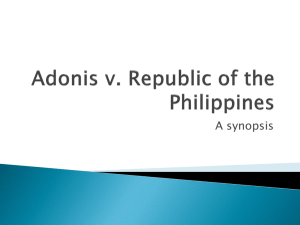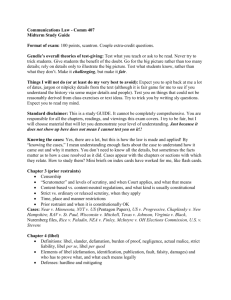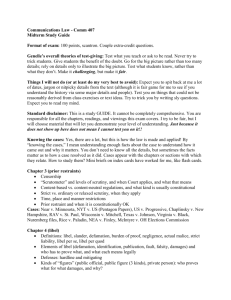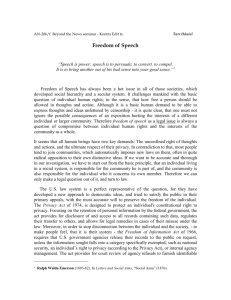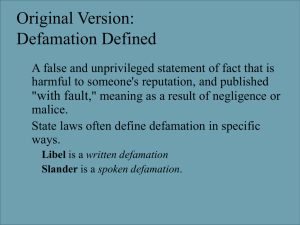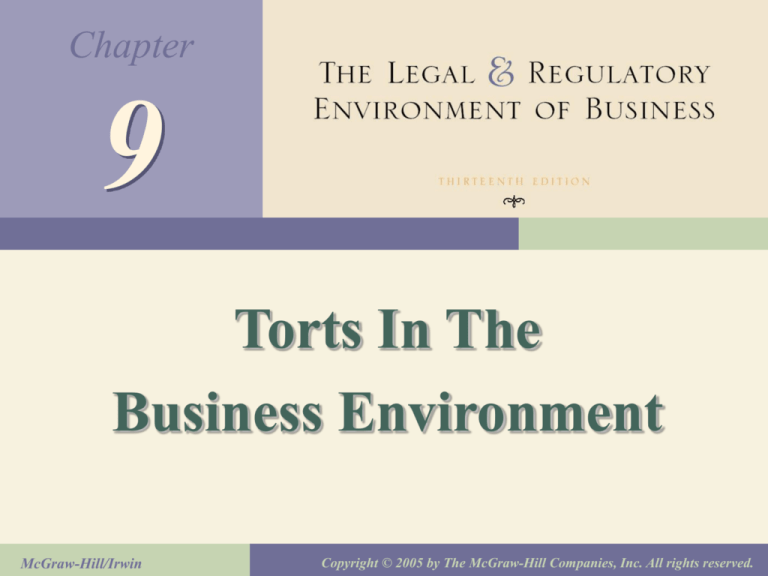
Chapter
9
Torts In The
Business Environment
McGraw-Hill/Irwin
Copyright © 2005 by The McGraw-Hill Companies, Inc. All rights reserved.
Definitions
Tort- Civil Wrong Other Than
Breach Of Contract
Tortious Behavior- Results In
Tort
Tortfeasor- One Who Commits
Tort
Types Of Torts
• Intentional
• Negligence
• Strict Liability
9-2
Types Of Tort Cases
Medical
Malpractice
Toxic Substance
Product Liability
Dangerous
Property
Auto Accident
0%
10%
20%
30%
Source: U.S. Department Of Justice, Office Of Justice Programs, Bureau of Justice Statistics
40%
50%
60%
9-3
Tort Case Depositions
80%
70%
60%
50%
40%
30%
20%
10%
0%
Agreed Dismissed
Upon
Settlement
Jury
Verdict
Source: U.S. Department Of Justice, Office Of Justice Programs, Bureau of Justice Statistics
Bench
Trial
Verdict
Unknown
9-4
Intentional Torts
Intent- Desire To Bring About Certain Results
Trespass
Assault & Battery
Infliction Of Mental
Distress
Conversion
Defamation- Public
Or Private Person
Invasion Of Privacy
False Imprisonment
& Malicious
Prosecution
Fraud & Corporate
Governance
Common Law
Business Torts
9-5
Intentional Torts
Elements
• Harm to Person or Property
• Intent
Burden of Proof: Plaintiff must
establish defendant’s liability by a
preponderance of the evidence
Damages
• Compensatory - To make right
• Punitive - To Punish
9-6
Interference- Personal Rights
Battery
• Intentional
• Unconsented to touching
Actual bodily contact
not required
Enough to set in
motion
Free & Intelligent
Consent a Defense
• Harmful or Offensive
To person of ordinary
sensibility
(Double-Click the picture
to see an example of a
battery)
9-7
Interference- Personal Rights
Battery
• Leichtman V. WLW Jacor Communications,
Inc.
An antismoking advocate is allowed to
sue for battery after a talk-show host
purposely blows smoke repeatedly in his
face.
What harm did Leichtman suffer?
The touching need not injure the person
Note: This probably would not have been
considered a battery a few years ago.
9-8
Interference- Personal Rights
Assault
• Put in apprehension of
• Imminent (Immediate) Threat
• To Physical Safety
• Actual Contact not required
• Usually, “mere words” not
enough
9-9
Interference- Personal Rights
False Imprisonment
• Intentional Confinement
• For an Appreciable Time
• Without Consent
• Substantially Restricting
• Stores often given
Conditional Privilege vs.
Shoplifting Suspects
9-10
Interference- Personal Rights
Intentional Infliction of Mental
Distress
• Some jurisdictions require
physical manifestation
• Requires “Outrageous” Conduct
(e.g. Substantially certain to
produce distress to person of
ordinary sensibilities
9-11
Interference- Personal Rights
VAN STAN v. FANCY COLOURS & CO.
1997 U.S. App. LEXIS 2442 (7th Cir.)
FACTS: After Fancy Colours fired Van Stan, he sued claiming
intentional infliction of emotional distress and violation of the Americans
with Disabilities Act. A jury awarded Van Stan $150,000 on the emotional
distress claim, but determined that the employer’s conduct did not
violate the ADA.
ISSUE: As a matter of law, did Fancy Colours’ conduct constitute
the tort of intentional infliction of emotional distress?
DECISION:
No.
REASON:
Even if the employer phoned Van Stan when he
was home on vacation, told him he was fired, and falsely informed him
the firing was due to low productivity, this conduct does not rise to the
level of “extreme and outrageous” behavior necessary for the tort that
exceeds “all possible bounds of decency.”
9-12
Interference-Personal Rights
Defamation
• A false and unprivileged publication that injures a person’s
reputation or character
Libel (Writing)
Slander (Speech)
• Levinsky’s Inc. v. Wal-Mart
• A store is allowed to sue for defamation on the basis of a
statement made by a competitor’s manager.
• The difference between fact and opinion is central to this
case. Because the 20-minute hold statement was capable
of verification, the court remanded the case for a new trial.
• Note: Levinsky’s also sued for false light, deceptive trade
practices, interference with advantageous economic
relations, and infliction of emotional distress, but the only
issue on appeal was defamation. The jury awarded
Levinsky’s $600,000 for presumed damage to its
9-13
reputation.
Interference-Personal Rights
Libel
• Elements of a Libel Claim
1. Defamatory statement
2. Identification
3. Publication
4. Fault
5. Falsity
6. Personal Harm
9-14
Defamation
Libel
• Publication
A statement is "published" if it is
communicated to someone other than the
person whom the statement is about.
In the case of newspapers, magazines,
radio television, or wire services, the
libeled person does not have to prove that
someone read or heard the defamatory
statement. (Theory: too burdensome to
check)
9-15
Defamation
Libel
• Publication
Note: Intracompany communications do not
constitute actionable publications. Publication is
the communication of defamatory matter to a third
person, and neither agents nor employees of a
company are third persons in relation to the
corporation because they are part and parcel of the
corporation itself. The statement, she’s in big
trouble’, was communicated to a third party.
Whether this comment imputes the commission of
a crime or tends to injure the victim’s professional
reputation and therefore constitutes slander per se
is a question for the jury. A claim of slander per se
renders irrelevant the absence of evidence that a
comment actually sullied the victim’s reputation.
Starr v. Pearle Vision, Inc., 54F.3d 1548 (10th Cir.
1995).
9-16
Defamation
Libel
• Fault
In order to be "at fault" in publishing a statement, the
person suing must prove that the reporter either did
something they should not have done or that they
failed to do something that they should have done. If
the reporter did everything a "reasonable reporter"
should have done to verify the information in his or
her story before publishing it - for example, talked to
all sides, obtained and read all relevant documents,
took accurate notes, etc. - the reporter is not legally
"at fault."
9-17
Defamation
Libel
• Harm
A statement is harmful if it seriously
shames, ridicules, disgraces or
injures a person's reputation or
causes others to do so. Statements
that are mildly embarrassing or
merely confusing or inaccurate will
not meet the "harm" test.
Not need to prove actual (e.g
money) damages (as with slander)
9-18
Defamation
Libel per se
• A clear, unambiguous, commonly-agreed-to meaning. Some types of words
like “unethical, adulterer, thief, cheat, criminal, liar, drunkard,
communist...” are universally interpreted as defamatory. No surrounding
context or factors need to be considered.
• Note: Standards can and do change. In 1998, a New York court ruled that
the use of the word “bitch” was not libelous.
• Related recent news item: May 29, 2004, Judge: Homosexual Isn't Libelous
Term
Stating that someone is homosexual does not libel or slander them,
particularly in light of new court decisions granting gays more rights, a
federal judge has ruled. The ruling by U.S. District Judge Nancy Gertner
came as she threw out a lawsuit by a former boyfriend of pop singer
Madonna who claimed he was libeled because his name appeared in a
photo caption in a book about Madonna under a picture of Madonna
walking with a gay man. "In fact, a finding that such a statement is
defamatory requires this court to legitimize the prejudice and bigotry
that for too long have plagued the homosexual community," she wrote
in her opinion Friday. (from the AP via ABCNews.com.)
9-19
Defamation
Libel per quod
• Not apparent in the words
themselves. These are
communications that are
defamatory only when other
facts or contexts are taken
into consideration; this is an
indirect libel; an implied
defamatory comment.
9-20
Defamation
Libel
• Examples of some libel awards
1991 largest Libel judgment in U.S. History: $58 M.
to Texas district attorney Vic Feazel, who was
falsely accused by WFAA-TV in Dallas of taking
bribes to fix drunken driving and drug possession
cases. They ultimately settled out out court for a
smaller amount.
1993 New York appellate court upheld an $18.5 M.
dollar award against Buffalo TV station WKBW for
incorrectly associating a restaurant owner with
organized crime. Later reduced to $15.5 M. A retrial
was ordered because of faulty jury instructions
and that jury awarded $11.5 million in damages.
9-21
Interference-Personal Rights
Slander (Speech)
Intracompany communications do not constitute
actionable publications. Publication is the
communication of defamatory matter to a third person,
and neither agents nor employees of a company are third
persons in relation to the corporation because they are
part and parcel of the corporation itself. The statement,
she’s in big trouble’, was communicated to a third party.
Whether this comment imputes the commission of a
crime or tends to injure the victim’s professional
reputation and therefore constitutes slander per se is a
question for the jury. A claim of slander per se renders
irrelevant the absence of evidence that a comment
actually sullied the victim’s reputation. Starr v. Pearle
Vision, Inc., 54F.3d 1548 (10th Cir. 1995).
9-22
Defamation- Standards
In re: Media - Public Officials or Public Figures Must Prove “Actual
Malice”
• See New York Times Company v. Sullivan, 376 U.S. 254 (1964)
(for Public Figures)
http://caselaw.lp.findlaw.com/scripts/getcase.pl?court=US&vol=37
6&invol=254
• See Curtis Publishing Co. v. Butts, 388 U.S. 130 (1967) (for Public
Official)
http://www.law.cornell.edu/supct/html/historics/USSC_CR_0388_0
130_ZS.html
In order for a public official or a public figure to prove defamation,
they must prove actual malice. Actual malice requires that the
person suing prove that the challenged statement was published
by those who either knew it was false or were reckless in verifying
its accuracy.
• Malice typically may not be inferred, but must be proven by
competent evidence
9-23
Defamation- Standards
In re: Media - Public Officials or Public Figures Must
Prove “Actual Malice”
The First Amendment recognizes the fundamental
importance of the free flow of ideas and opinions on matters
of public interest and concern. A public figure may hold a
speaker liable for publication of a defamatory falsehood if it
was made with malice. If it were not required, political
cartoons and satires would be imperiled. These have had an
effect on the course and outcome of public debate; our
political discourse would have been poorer without them.
There is no doubt that the caricature of Falwell and his
mother is at best a distant cousin of the political cartoon,
and a rather poor relation at that. But it would be too hard for
a jury to distinguish between this and desired speech
without a malice standard. Hustler Magazine Inc. v. Falwell,
485 U.S. 46 (1988).
9-24
Interference-Personal Rights
Defamation – Who is a Public Figure?
• Private Person v. Public Figure
Public figures are those who have chosen to thrust
themselves into the limelight.
There are two categories:
• (1) General Purpose Public Figure: is a an individual
who has assumed a role of special prominence in the
affairs of society and occupies a position of persuasive
power and influence or is a "celebrity," whose
pervasive fame or notoriety has made his or her name
a "household word."
• (2) Limited Purpose Public Figure: someone who has
voluntarily assumed a leading role in a particular
public controversy.
9-25
Defamation- Standards
Private Persons
• In most states, a private person need only prove that a reporter was
negligent, that is, that the reporter made a mistake - perhaps an
innocent one - that a "reasonable" reporter should not have made.
• If not public figure, must prove actual malice ONLY when the
defamatory falsehoods related to the controversy they associated
themselves with.
• Supreme Court's decision in Gertz v. Robert Welch, Inc. 418 U.S.
323 (1974)
http://wyomcases.courts.state.wy.us/applications/oscn/deliverdocu
ment.asp?citeid=429791
Court held that in defamation suits by a private figure arising
out of matters of public concern, the states may set any
standard of care except strict liability. Most states chose
negligence as the standard of care for defamation defendants in
a Gertz situation. (see also: Dun & Bradstreet, Inc. v.
Greenmoss Builders, 472 U.S. 749 (1985),
http://caselaw.lp.findlaw.com/scripts/getcase.pl?court=US&vol=472&i
nvol=749)
9-26
Defamation- Defenses
Truth - is a complete defense
Privilege
• Absolute Privilege - (e.g. Statements by members
of Congress on the floor, participants in certain
judicial proceedings, private statements between
spouses)
• Conditionally Privileged - e.g. Employee
references (lawyers generally recommend not
giving such)
• Note: Other privileges exist, but vary from
jurisdiction to jurisdiction.
Opinion - A statement of mere opinion cannot be
9-27
defamatory
Defamation- Defenses
Possibly Retraction?
• Must be “Full and fair”=
same type, position and
page
9-28
Defamation- Defenses
Statutory Immunity
• Carafano v. Metrosplash
• The lawsuit against Metrosplash/Matchmaker was prevented by the
Communications Decency Act.. The Communications Decency Act immunizes
those who give access to the Internet from liability for messages that originate
with third persons. Specifically, the statute precludes courts from entertaining
claims that would place a computer service provider in a publisher's role. The
purpose of this immunity is not difficult to discern. It was enacted to maintain the
robust nature of Internet communications and, accordingly, to keep governmental
interference in the medium to a minimum. None of this means, of course, that the
original culpable party who posts defamatory messages would escape
accountability. However, Congress made a policy choice not to deter harmful
online speech through the separate route of imposing tort liability on companies
that serve as intermediaries for other parties' potentially injurious messages. The
specter of tort liability in an area of such prolific speech would have an obvious
chilling effect. Faced with potential liability for each message republished by their
services, interactive computer service providers might choose to severely restrict
the number and type of messages posted. Ask the students what they think
about the legislation? Discuss the advantages and disadvantages of such a
policy. Obviously, in the Carafano case, if a newspaper or magazine ran the bogus
9-29
“profile” in its personals, the result would have been different.
Defamation - Other
Countries
In many other countries, such as Canada,
Australia, South Africa “a claim to dignity
or to personality will trump a claim to
freedom of speech. In Germany, the
burden is on newspapers to verify the
truth of their statements. German Law
also states that freedom of speech "shall
find its limits ... in provisions for the
protection of young persons, and in the
right to personal honor.” - Source: Donald
Kommers, professor of law and political science
at the University of Notre Dame, discussion on
free speech and defamation 3-1-2006, part of the
Democracy Dialogues series of discussions on
freedom of speech.
9-30
Interference- Personal Rights
Invasion of Right to Privacy
• Intrusion on Privacy (e.g.
obscene phone calls)
9-31
Interference- Personal Rights
Invasion of Right to Privacy
• Widespread Dissemination
Publishing private facts
False Light
9-32
Interference- Personal Rights
Invasion of Right to Privacy
• Misappropriation of Name or
Image for Commercial Purposes
White v. Samsung Electronics
America, Inc.
• Letter turner Vanna White is allowed
to sue when an ad uses a robot
mimicking her movements and
style.
9-33
Interference- Personal Rights
Misuse of Legal
Proceedings
• Wrongful Use of Civil
Proceedings
• Malicious Prosecution
• Abuse of Process
9-34
Interference-Property Rights
Trespass to Land
• Entry
• Without Permission
or Privilege
9-35
Interference-Property Rights
Trespass to Personal Property
• Intentional Interference with Personal
Property that:
Harms property or
Deprives Possessor of Use for
Appreciable Time
• Conversion: Unlawful exercise of control
Arnold Palmer Cadillac Example
9-36
Interference-Economic
Relations
Disparagement - False statements
about quality of services or goods
• Proof of damage required
Interference With Contract - induce
breach
Interference With Economic
Expectations - forcibly drive away
customers
9-37
Interference with a Marital
Relationship (NC and some other
jurisdictions)
Criminal Conversation - To succeed on a
criminal conversation claim, the plaintiff has to
show:
• (1) an act of intercourse between defendant
and plaintiff’s spouse and
• (2) the existence of a valid marriage between
the plaintiff and the adulterous spouse, and
• (3) the bringing of the lawsuit within the
applicable statute of limitations.
9-38
Interference with a Marital
Relationship (NC and some other
jurisdictions)
Alienation of Affection - To succeed on an alienation claim,
the plaintiff has to show that:
• (1) the marriage entailed love between the spouses in
some degree;
• (2) the spousal love was alienated and destroyed; and
• (3) defendant’s malicious conduct contributed to or
caused the loss of affection. It is not necessary to show
that the defendant set out to destroy the marital
relationship, but only that he or she intentionally
engaged in acts which would foreseeably impact on the
marriage.
see http://www.rosen.com/ppf/ID/37/alien.asp
9-39
Common Law
Business Torts
Injurious FalsehoodTrade Disparagement
Intentional
Interference With
Contractual Relations
9-40
Cyber Torts
Defamation
Intentional Infliction Of
Mental Distress
Hackers &
Misappropriation Of
Trade Secrets
Fraud
9-41
Negligence-Based
Torts Elements
Elements:
• Breach of Duty
• Proximate
Cause
• Injury
• (For an example
of negligence
double-click the
picture)
9-42
Duty
• Objective Standard
Flexible
Reasonable Person of Ordinary
Prudence in Similar Circumstances
Relationship/Special Skill Factor
Trespassers/Licensees/Invitees
“Sudden Emergency”/”Good
Samaritan” Exceptions
“Duty to Act” Statutes
9-43
Duty
IANNELLI v. BURGER KING CORP.
2000 N.H. LEXIS 42 (N.H. Sup.Ct. 2000)
•
•
•
•
FACTS:
The plaintiffs, Nicholas and Jodiann Iannelli, individually and on behalf of their 3
children, brought a negligence action against the defendant, Burger King Corporation, for
injuries sustained as a result of an assault at the defendant’s restaurant. During the late
afternoon or early evening hours of December 26, 1995, the Iannelli family went to the
defendant’s restaurant for the first time. Upon entering the restaurant, the Iannellis became
aware of a group of teenagers consisting of five males and two females, whom they alleged
were rowdy, obnoxious, loud, abusive, and using foul language. Some in the group claimed
they were “hammered.” Initially this group was near the ordering counter talking to an
employee whom they appeared to know. The Iannellis alleged that one of the group almost
bumped into Nicholas. When that fact was pointed out, the teenager exclaimed, “I don’t give
an F. That’s his F’ing problem.”
Nicholas asked his wife and children to sit down in the dining area as he ordered
the food. While waiting for the food to be prepared, Nicholas joined his family at their table.
The teenagers also moved into the dining area to another table. The obnoxious behavior and
foul language allegedly continued. One of the Iannelli children became nervous. Nicholas
then walked over to the group intending to ask them to stop swearing. As Nicholas stood two
or three feet from the closest of the group, he said, “Guys, hey listen, I have three kids.”
Whereupon, allegedly unprovoked, one or more of the group assaulted Nicholas by hitting
him, knocking him to the ground and striking him in the head with a chair. The trial judge
ruled that as a matter of law the defendant owed no duty to the plaintiffs to protect them from
assault.
ISSUE:
As a matter of law, did the defendant owe a duty of care to the plaintiff?
9-44
Duty
• IANNELLI v. BURGER KING CORP.
• 2000 N.H. LEXIS 42 (N.H. Sup.Ct. 2000)
• DECISION: Yes.
• REASON: Burger King by allowing the
rowdy attackers to be in the restaurant
when it was foreseeable that criminal
conduct might result owed a duty of
reasonable care to its other customers.
9-45
Duty
• Negligence Per Se
by Statute
Injury of Type Designed to
Protect Against
Plaintiff within Group intended
to Protect
9-46
Negligence
Breach
• Foreseeable
• Unreasonable Risk
• Reasonable Person
9-47
Causation
• Cause in Fact
• Proximate Cause
Defendant’s failure to conform to
required standard of conduct
proximately caused injury
“But for” Test
• Foreseeability
• “Egg Shell Plaintiff” Rule
9-48
Negligence
Res Ipsa Loquitur
• Cause difficult to prove
• Defendant exclusive control
of instrument causing injury
• Injury ordinarily not occur
without negligence
• Shifts burden of proof to
Defendant
9-49
Negligence
Negligent Infliction of
Emotional/Mental Distress
• Serious emotional distress
• Foreseeable
Dogs “First Bite” Rule/”Vicious
Propensity”
• May be 3rd party witnessing (e.g.
Mother watching child hit by
school bus)
9-50
Negligence- Defenses
Last Clear Chance
Intervening/Superseding
Force
9-51
Negligence- Defenses
Contributory vs.
Comparative Negligence
9-52
Negligence- Defenses
Assumption of Risk
• (Hockey game examples, fan
in the stands, players)
9-53
Strict Liability
Person participates in activities responsible for
harm to others despite care/caution
• Ultrahazardous activities
• Factors to be considered in determining
whether something is abnormally dangerous
• High degree of risk of harm?
• Likelihood of great harm?
• Inability to eliminate risk by reasonable
care?
• Extent to which activity not common use?
• Inappropriateness of activity to place?
• Value outweighed by risk?
9-54
Current Issues- Torts
Liability Insurance- Crisis
• Higher Premiums
• Reduction in Coverage
• Refusal of Coverage
Reform Measures
• Limit on Non-Economic Damages
• Limit on Punitive Damages
• Regulation of Insurers
9-55
Strict Liability In Torts
Strict Product Liability-
Unreasonably Dangerous
Defective Products
• Production Defect
• Design Defect
• Warning Defect
Respondeat Superior- Scope Of
Employment
Ultrahazardous Activity
9-56
Other Strict Liability Torts
Dram Shop Acts- Intoxication
(Tavern Owners Liable)
Common Carriers Not Liable For:
• Acts Of God
• Action Of Alien Enemy
• Order Of Public Authority
• Inherent Nature Of Goods
• Misconduct Of Shipper
9-57
Compensatory Damages
Compensation For Injuries
Suffered
Types:
• Past/Future Medical Expenses
• Past Future Economic Loss
• Past/Future Pain Suffering
Calculation- Difficult
9-58
Punitive Damages
Used To Punish Defendant
Negligent Behavior “Gross” or
“Willful & Wanton”
Exemplary Damages
9-59
Tort Reform
Actions Against Retailers Or
Wholesalers Unless Manufacturer
Insolvent
No Recovery For Defective Design
No Claims Against Sellers If
Product Modified By User
State-Of-The-Art
Statute Of Repose
Reduce/Eliminate Punitive Damage
Awards
9-60
Alternatives To
Tort System
Disadvantages Of Tort System
• Contingency Fee- Suit Without
Up-Front Attorney’s Fees
• 40-60% Of Damages Go To
Plaintiff
Alternatives
• Arbitration
• No-Fault Insurance
• Workers’ Compensation
9-61
Workers’ Compensation Acts
Protect Employees/Families From
Job-Related Risks
Employer Acted Unreasonably
Defenses
• Assumption Of Risk
• Contributory Negligence
• The Fellow-Servant Rule
Tests For Compensation
• Injury Accidental
• Result Of Employment
Exclusive Remedy Rule
9-62

